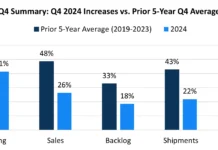by Will Hinshaw, partner/founder, Captive Solutions & Options
What if submitting a receipt for an oil change to the car insurance company for reimbursement was possible? Unfortunately, it is not allowed because routine maintenance is not covered under a car insurance policy. Insurance, by definition, is a contract represented by a policy in which an individual or an entity receives financial protection and/or reimbursement against losses from an insurance company. It intends to limit the liability of the policyholder in the worst-case scenarios. Why then does the US healthcare system operate differently – where routine medical maintenance procedures (well care, such as immunizations, mammograms, colonoscopies, etc.) are covered or reimbursed by the health insurance company? The answer is risk.
Risk management is the identification, evaluation and prioritization of threats to an organization. With health insurance costs, managing risk and the potential exposure to a company often is achieved by being a part of a large [risk] pool with little control or transparency, or through a stand-alone program that offers greater control and transparency, along with an increased level of risk. There is a strategy (see sidebar) that offers the best of both worlds – the strength of aggregation with the control and transparency of individual plans – where the approach is to provide accessible coverage for when things go bad.
Whether it’s a group as small as three or as large as three thousand, the very purpose of insurance, a mechanism to protect against unforeseen costs, is needed to protect the human capital asset – employees and dependents – from the risk associated with medical conditions. To create a large enough financial reserve to protect against the $1 million pre-mature birth, the $25,000 a month prescription or the $500,000 cancer diagnosis, most companies pool the risk through a fully insured health plan. While this method protects against loss by capping the company’s overall financial liability, it limits data transparency and the ability to pinpoint costs and develop courses of action to remedy them. Additionally, the fully insured model prepays for bills that might occur, not what actually has occurred. For this reason, the fully insured methodology can more accurately be categorized as risk avoidance, not risk management.
To actively engage in managing risk and receive reimbursement, an employer must participate in what is commonly referred to as a partially self-funded program. In this model, the employer covers the costs of medical procedures up to a specific financial limit for each individual while also limiting financial liability for the sum of all medical expenditures via third-party insurance. The insurance entity provides reimbursement to the employer for medical claims that exceed either the individual specific limit or the overall company expenditure value. Under this platform, employers are provided clear data about their medical claims and are given greater choice in determining the service providers and structure of their health benefits plan. These choices are predicated on the overarching goals and objectives of the employer’s own risk management strategy.
While the partially self-funded plan is better, its policy – just like the fully insured offering – is based on a premium that is collected by a third-party insurance entity. The premiums are repurposed by the insurance company to cover the reimbursements or expenses incurred through submitted claims. Should the funds associated with the premiums need to be utilized, insurance companies will charge for spending the money received as premiums. Therefore, it is best to avoid this whenever possible. With car insurance, this easily is achieved. The balance between the affordability for a repair – the deductible – is balanced with the costs associated with certain repairs. The estimate or quote to repair the damaged bumper may exceed the deductible.
However, the difference in cost over the deductible might still be more cost-efficient than the long-term impact of higher premium rates from filing the claim to have the repair covered via insurance. In this situation, the availability of the cost data makes this decision much easier. Unfortunately, with healthcare, the costs of medical services and prescription drugs (and/or the lack of transparency for the associated costs) are not as apparent. Only in the US healthcare delivery system do we blend the elements of insurance and service payment. Appropriately, this was done to address the opaque nature of the service fees and possibly the high-cost health care services associated with individual plan member risk.
Will Hinshaw has dedicated over 25 years to leading organizations in numerous industries, including CAPTIV8, MAPP’s new funding strategy for members. For more information on pharmaceutical cost-containment strategies, or to learn more about CAPTIV8, contact Susan Denzio, sdenzio@firstresourceinc.com.
The CAPTIV8 Strategy for When Things Go Bad
The paradigm is shifting as CAPTIV8 is changing the way insurance premium dollars can better serve its members by leveraging the fully insured methodology of pooling with the control and transparency of a self-insured model.
This program utilizes a unique contracting approach by putting employer premiums to work for its members, specifically during bad times. The CAPTIV8 program facilitates multiple partially self-funded employers aggregating a majority of the premium for one sole purpose – to be utilized by its members. In the event it is utilized for claims, because it is member premium supporting other members’ needs, the insurance entity (the captive) does not need to recoup the premium as aggressively at renewal. In fact, given the captive premium is going to be returned to the members through either expense reimbursements or profit distributions, there is no need to charge for its use.
Instead, the increase associated with the utilization of these premium dollars is directly linked to the forward-looking projection of risk for the individual or group of individuals who generated the claims – not a penalty for using the premium. By sharing the premium, members are insulated from market factors and the pricing of commercial insurance.
Recently, a CAPTIV8 member was the direct beneficiary of this shared premium model which sustains the captive members and not the insurance companies. After a particularly bad claims year, where reimbursements exceeded premium deposits by more than 300%, the member’s renewal was 15% below the market. The benefit of aggregated premium contributions, in combination with the fact that other member withdrawals did not exceed contributions, allowed this member to renew at a lower cost.
While the member’s premium alone was not enough, in a model that encourages the spending of the member premium, it was more than enough.
More information: sdenzio@firstresourceinc.com.





